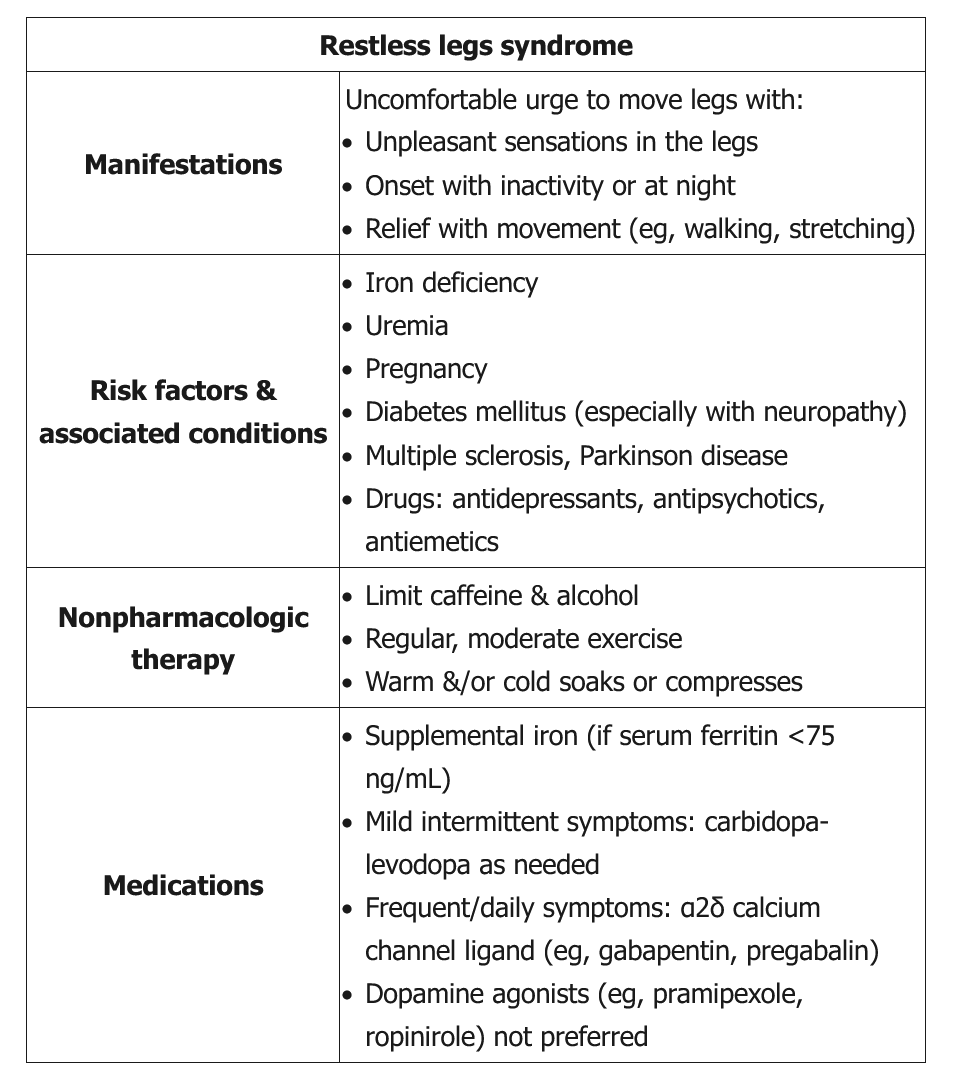Sleep Disorders - Step 2
- related:
Narcolepsy
Sleep Apnea
Sleep apnea is characterized by periods of breathing cessation that occur during sleep. There are two types:
- Obstructive sleep apnea is the obstruction of respiration due to the weight of tissue compressing the airway. Rule out obstructive sleep apneain an obese patient with daytime fatigue.
- Central sleep apnea is characterized by a lack of central respiratory drive.
In obstructive sleep apnea, chronic hypoxemia due to nocturnal apnea has a multitude of cardiovascular complications:
- Pulmonary hypertension (as well as potential for cor pulmonale)
- Systemic hypertension
- Arrhythmia
- Polycythemia
Central sleep apnea can be caused by:
- Neurological conditions (e.g. stroke, Parkinson's, etc.)
- High-altitude climbing
- Nocturnal Cheyne-Stokes breathing (secondary to conditions such as heart failure, toxic encephalopathy, and renal failure)
Both types of sleep apnea are diagnosed with polysomnography during sleep.
The mainstay of treatment of both types of sleep apnea is **CPAP **(continuous positive airway pressure). Additional measures include treatment of the underlying cause (weight loss for obstructive sleep apnea, and resolution of underlying pathology in central).
Restless leg syndrome

Restless leg syndrome is a subjective feeling of restlessness and an uncomfortable sensation in the legs that is relieved by moving them. Iron deficiency is an important correctable cause to rule out; also look for symptoms or associated characteristics of iron deficiency, such as pica, a history of chronic menorrhagia, etc.
The most effective pharmacological treatment for restless leg syndrome is a dopamine agonist such as ropinirole or pramipexole. Alternatively, anticonvulsants (especially gabapentin), opioids, benzodiazepines can be used.
KleineLevin
Rare disorder in which patients experience **hypersomnia, hyperphagia, hypersexuality, and aggression. **The diagnosis is clinical. Patients sleep a median of 18 hours/day during hypersomnic episodes.,
Parasomnia
Parasomnias are abnormal behaviors or experiences that occur during sleep, often disturbing the patient and affecting sleep quality. They include:
- REM sleep behavior disorder
- Sleepwalking
- Sleep terrors
- Nightmare disorder
Parasomnias, particularly REM sleep behavior disorder, are caused by an incomplete inhibition of skeletal muscle during REM sleep.
Nightmare and terror
A key difference in distinguishing nightmare disorder from sleep terrors is that patients with nightmare disorder recall their dreams. This is because of the difference in sleep stage during which the nightmares/terrors occur.
Sleep terrors are episodes of sudden arousal with screaming. Patients do not recall their dream and may be disoriented upon waking. Sleep terrors occur during sleep stages N3-4 (delta wave sleep).
Nightmares in nightmare disorder occur during REM sleep.
Nightmare kids are consolable. Night terror kids are inconsolable.
Nightmare disorder is marked by recurrent frightening dreams, which are particularly vivid. This disorder has a strong association with PTSD.
Imagery rehearsal therapy (IRT) involves using mental imagery to modify the outcome of a recurrent nightmare. It is very successful in treating recurrent nightmares in PTSD.
REM Sleep Disorder
Characterized by dream-enacting behaviors, where patients may jerk limbs, walk, yell, and perform various actions. The first line treatment is melatonin, and second line is clonazepam.,
Rapid eye movement (REM) sleep behavior disorder is characterized by complex motor behaviors that occur during REM sleep. Dream enactment can occur if the muscle atonia that usually accompanies REM sleep is absent or incomplete. These behaviors are more likely to occur during the latter part of the night, when the percentage of REM sleep is higher. Patients can be awakened quickly, and after very transient confusion can become fully alert. They may not recall their movements during sleep but can recall their dreams.
REM sleep behavior disorder is more likely to occur in older adult men. If frequent and recurrent, it may be a prodromal sign of neurodegeneration in patients with Parkinson disease or dementia with Lewy bodies. It occurs with other prodromal symptoms such as subtle motor deficits (eg, changes in gait), anosmia, and constipation.
Sleep walking
Links to this note
Sleepwalking is characterized by walking during sleep, with or without the presence of other complex behaviors. Patients' eyes are open with a "glassy" look, and they have amnesia for the episode. Sleepwalking is associated with:
- Sleep deprivation
- Stress
- Hyperthyroidism
- Sleep apnea
- Magnesium deficiency